Last updated on September 26th, 2023 at 02:19 am
We are reposting the speech by our Marija Stajić, presented at the Round-table discussion themed “War against Family in Culture” as part of the 9th Week of Family Unity, organized by Porodični Sabor organization on 8 September 2023. The article was first published in Pečat magazine, No 779, of 22 September 2023.
IFamNews
Reader discretion is advised: the article contains graphic illustrations that may be disturbing to some persons.
In recent years, we’ve been hearing increasingly often that somewhere in the USA a book with openly pornographic content was found in a school library, with content inappropriate for the intended age group. This July, a piece of information was shared on social media that one such book was discovered in the schools of the Fort Worth education district in Texas, after which an order came that all the books in the school libraries should be examined and their adequacy assessed. Initially, three books were removed, and by the end of August, the number exceeded one hundred.
Under a new bill (HB 900) signed by Texas Governor Greg Abbott, such books must be labeled either as “sexually explicit,” meaning they will be removed from school libraries, or as “sexually relevant,” which means that the student needs parental consent before borrowing.
When Fox4 reported on the books, they said they were “unable to air certain images from the books because they are too graphic,” meaning the broadcaster could be fined for airing inappropriate content. Parents are well within their rights when they ask why is material that is not allowed to be broadcast publicly on television at the same time readily available to children in school libraries.
On Amazon’s website, Wait, What is listed as the Chicago Public Library’s “Best of the Best Books of 2019”, one of the “best LGBTQ graphic novels of 2019 ” and an “outstanding children’s book” according to the Association of Children’s Library Services, a branch of the American Library Association. By the way, in July this year, Emily Drabinski, a self-described Marxist lesbian, was elected the president of this Association and stated that the fight against “a record number of attempts to ban books across the country” is one of the goals of her administration.
“Wait, What” is written by Heather Corina, author of several sex education books, winner of several sex education awards, and a woman who goes by they/them pronouns, thus her bio states that these awards are for “their contribution to sex education” and that “they often take three minutes of time after work to deal with flowers, cooking, to walk the dog” and the like.
Amazon states that this graphic novel “covers essential topics for preteens and young teens about their changing bodies and feelings.” The book is “inclusive of different kinds of genders, sexualities and other identities.” It is intended for ages 9 to 14.
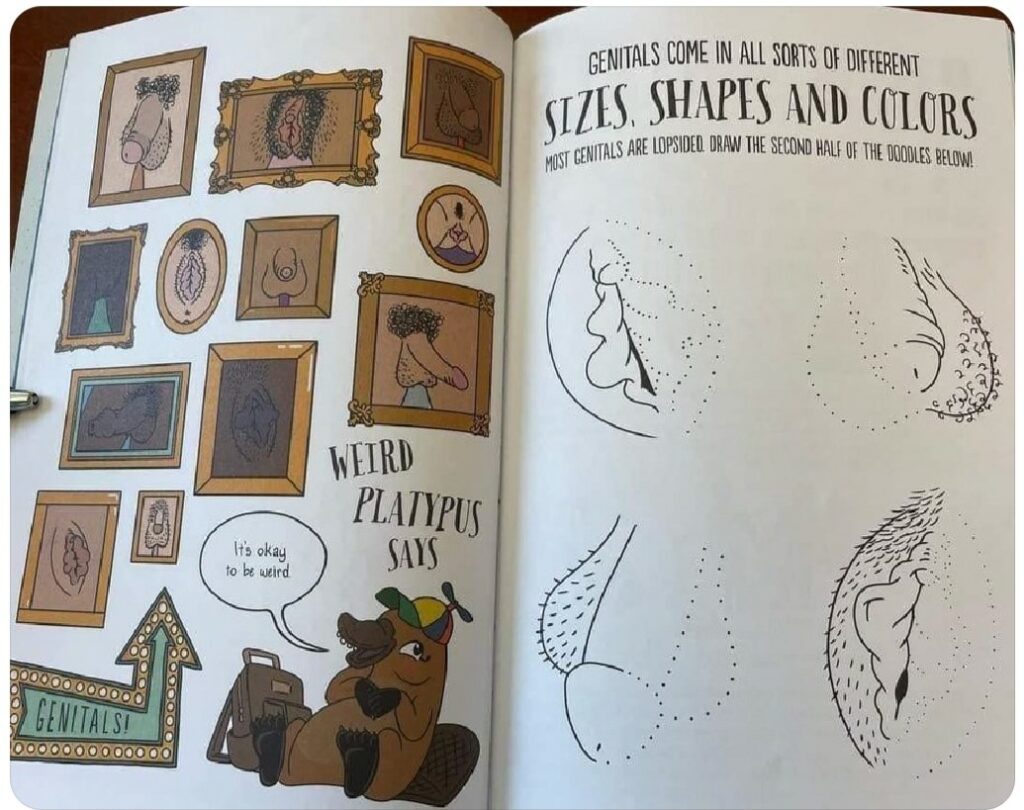
The book is written from the point of view of five children, one of whom uses they/them pronouns, and the other child is a girl who thinks she is a boy. The book shows drawings of male and female genitalia in different stages of sexual arousal, and there are also unfinished connect-the-dot type drawings where children need to complete those depictions of genitalia. For example, the book encourages children to masturbate, stating that it is “healthy”, uses new-speak in which there are “boys, girls, people with penises and people with vaginas”, and on one page it reads:
“Are you gay?” Straight? Both? Neither?
Ugh! People make it like there’s only two options, and two kinds of people: gay or straight. But there are waaaay more than those two kinds of people, and waaaay more choices about that part of being a person than two!
It often seems like people are either gay or straight, but this just isn’t true! Loads of people fall somewhere in the middle, on the outside or feel different about this altogether.
Saying there are only gay people and straight people is like saying that there are only cat people and dog people.”
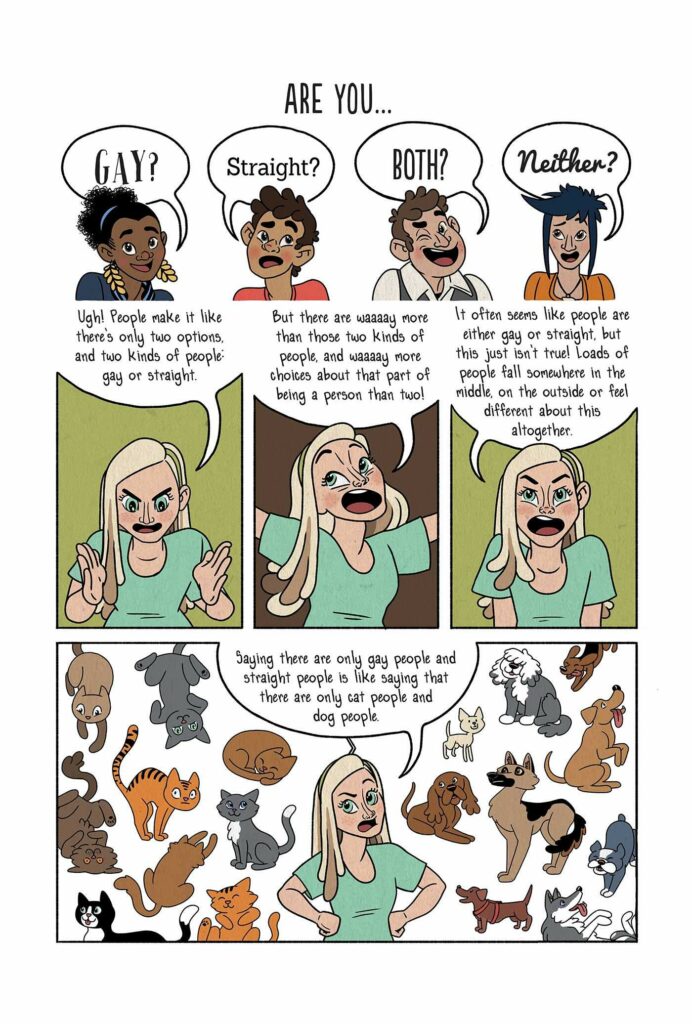
I will also add a sentence from a review on Amazon: “This book consistently puts the needs of its readers first, meticulously working to emphasize gender diversity, individuality, and the messiness of adolescence… Body parts are intentionally ungendered (or rather, androgynous), sexual orientations are shown as fluid and joyful, and there is a constant emphasis on the importance of friendship and mutual support.”
We see that this graphic novel unambiguously tells children and young people that human sexuality is fluid, that we are all queer-something to some extent, and instead of parental support, it highlights the importance of friendship and peers.
One other book is called “Let’s Talk About It” and it has also been removed or moved from the children’s to the adult section by several public and school libraries due to its explicit content. Amazon says it’s for ages 14–17, but authors Erika Moen and Matthew Nolan dedicate the book to “Anyone who needs it, whatever their age.”
The graphic novel is full of instructions about sex and masturbation, accompanied by detailed illustrations, it talks about “body positivity”, which is another product of the contemporary social justice discourse, talks about respecting other people’s personal pronouns and how to stay safe and not get on the wrong side of the law while having sex or watching porn. For example, the book says that:
- the anus is a “primo zone for touching and penetrating” because it has many nerve endings;
- erotic relationships can be monogamous, polyamorous, open, casual and companionate, which is accompanied by an illustration of three young people eating ice cream while a speech bubble says “Romantic relationships come in different flavors. There’s no wrong choice. You can explore as many or as few as you fancy”, which practically equates choosing a partner and his sex with choosing ice cream flavor;
- the gender binary is “an obsolete viewpoint based on a lack of understanding of just how diverse and nuanced people can be”;
- sexually transmitted diseases are “supercommon” but most are treatable and “if caught early, no biggie”;
- it is okay to consume pornography of all kinds as long as it is legal and as long as it does not interfere with one’s daily life;
- sending sexually explicit images by phone is fine as long as the sender and recipient follow all laws, have rules in place and don’t share the photos with others, as edit out their faces and personally identifying characteristics;
- “generally testosterone-rich bodies” have broad shoulders, facial hair, more musculature, but not necessarily penises;
- “generally estrogen-rich bodies” have broader hips, breasts, more body fat, but not necessarily vaginas;
- “lots of people medically change their bodies to have the traits that are right for them.”
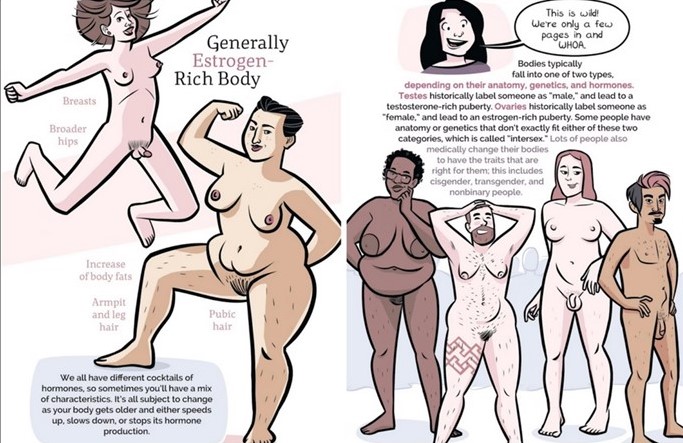
Those who defend this novel and claim that it is informative, that it gives young people answers to important security questions, that it is “open-minded” and similar seem to be completely blind to the facts about maturity, i.e. the immaturity of youth, about the typical reckless and careless behavior of adolescents, which is a consequence of insufficient maturity of the frontal lobe, which does not fully mature until their 20s, and they naively think that it is enough to write to young people that safety and consent are important, insert a few cartoonish illustrations and they will all apply that advice in life. Just tell them it’s not okay to forward someone’s sexual photos to others and they won’t do it, right? I have to wonder how no one has ever thought of simply telling young people how they should and shouldn’t behave. I will read two revolutionary sentences:
“Consent is communication and respecting boundaries. It’s getting to a place where you and the people you’re about to fool around with are on the same page, feeling informed, in agreement, and ready for what’s about to happen.”
The book tells young people that gender is “defined by the society and the culture you live in” – even though all societies and all cultures recognize two genders. Porn is presented as a “sugary treat.” “When consumed right,” the novel says, “porn can help you discover new aspects of your sexuality, and help you safely explore kinks and fantasies.”
And then follows a warning, with a drawing of two bodies having anal sex: “But, depending on your age and where you found it, porn can also be unethical or illegal to watch. So do your research!”, say the authors, concerned that young people don’t break the law. Instead of referring to parents and trusted people, it says: “Look up interviews with your fave porn performers, go to the sites they recommend and pay for your porn.” And for all its supposed talk about the novel teaching young people about safety, there’s no mention of being wary of online predators, or that adults grooming children is illegal or, for example, what to do if they come across porn that involves minors and the like.
For those who may not be familiar with these contemporary trends, especially parents, I will add that the term kink means unconventional sexual practices, concepts and fantasies. It is sometimes associated with BDSM, bondage and fetishes, and together with them it is classified under the umbrella term of paraphilia, i.e. extremes in sexual behavior. The fact that such content is recommended to young readers of this and similar books, while at the same time a large number of parents, school and library officials and policy makers have nothing against this – as long as young people are given the revolutionary warning about borders and security – is a tell-tale sign of the level of general decadence in the West today and what that “normal world” looks like, which our local leftists want so fervently to be a part of.
I will mention only one more book, “Gender Queer” by Maia Kobabe, who uses the untranslatable and non-existent pronouns “e/em/eir” for herself. This is a comic book memoir for 18+ — though it’s been found in several elementary and middle school libraries in Fort Worth County — in which the author describes her “coming out” to her family and friends. The book talks about breast binding, masturbation, sex toys, gay sex, oral sex, and the like, while Amazon’s website says it’s “an excellent handbook for those who identify as non-binary and asexual.” Documenting her life and the process of “coming out”, the author describes, among other things, how she got closer to her friends over a common interest, which is erotic gay novels.
It is interesting to read the reviews of readers who support such books. One reader wrote that the book is not pornographic, but immediately in the next sentence says, “The intention of the graphic scenes is to cause sexual excitement (although I found them strange and repulsive, to be honest).” This person is an example of a minion of today’s totalitarian system – he or she admits that such illustrations are repulsive, but at the same time defends the book against the attacks of the so-called extremists and conservatives. Such lukewarm people are as dangerous as the ideologues of totalitarian systems themselves. They have their own red line, but they often move it further and further, and usually explain their inaction or support for new trends by saying that it doesn’t affect them personally, and that people should be allowed to live as they want and love who they want – to which we’re now adding new items, such as to dress however they want, to present themselves in whatever gender they want, to use whatever pronouns they want – not realizing that you do not defend the country once the enemy is at your door.
These are the ones who don’t mind, for example, Doja Cat’s new song “Demons” in which she is literally disguised as a black demon with horns and red eyes. Portal Stereogum says that for her new album, Doja “has been playing around with satanic imagery, which is fun.” They’re the ones who also enjoy the song “Unholy” by non-binary singer Sam Smith which he performs with transgender Kim Petras who thinks he’s a woman, and which at the Grammy Awards in February this year, was performed with satanic scenography depicting scenes from hell. These are also the ones who also don’t mind the song by a gay rapper with a stage name Lil Nas X, “MONTERO (Call Me by Your Name),” in which the rapper plays Adam in the Garden of Eden who is seduced by the devil and later taken to Hell where he dances in Satan’s lap, then kills him, takes his crown and puts it on his own head. One of our local LGBT activists praised this “very queer video” as he says, and commented that it was “a great success and another proof that queer art can be commercial and part of the mainstream.”
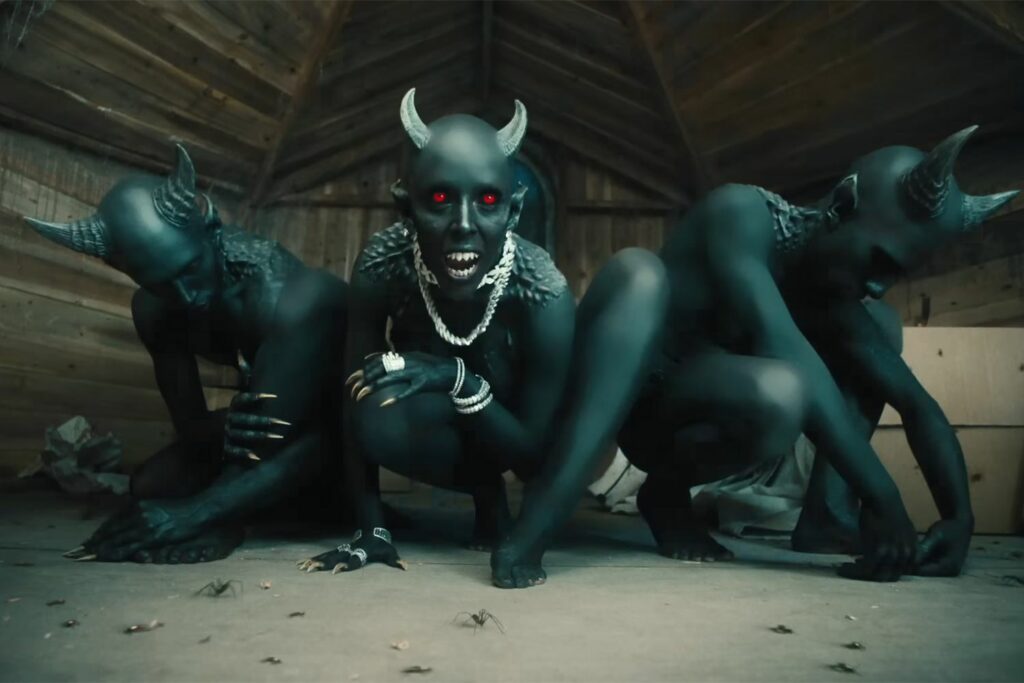
Lest our dissidents misunderstand me, it goes without saying that they have the right to use satanic imagery in their works. We’re not surprised by that because we know what is behind all that, and they only confirm this with such behavior. The problem arises when such ideas and values are played down as harmless and served to children, including those whose parents are raising them according to a different value system, which they are well within their rights to do.
In the end, I would just like to clarify that parents and activists who protest against these and similar books in libraries can in no way be equated with Nazis, as the media and social networks tend to portray them, because they are not advocating a “book ban” but merely, in accordance with the law, that certain materials are properly marked if they contain content unsuitable for minors and therefore should not be made accessible to children and minors, or that such books are borrowed with parental consent. Anyone is free to buy any of these books for their child, if they wish.
In contrast, it is precisely today’s leftists and progressives who are advocating for a true ban on books they don’t like; thus, in 2022 they tried to ban the publication of the autobiography of SCOTUS Justice Amy Connie Barrett because of her stance on abortion. In an attempt to justify the request to ban the publication of this book, the left-wing Human Rights Watch referred to the UN Universal Declaration of Human Rights, which allegedly declares access to abortion a human right. Of course, if your read the Declaration you can see that such a right is nowhere to be found, nor does it mention anything related to abortion, or even pregnancy and reproductive health.
Also, the aforementioned American Library Association issued guidelines this year on how to block individuals from gathering in public libraries if religious publishers want to organize events. Thus the publisher Brave Books was banned from holding book events with parents and children whose goal was to teach children about “faith, hope, and love,” as well as to “pray, sing, and read that publisher’s books and other books of virtue.” The American Library Association claims that this publisher “censors LGBTQIA materials and humiliates or silences library users who are LGBTQIA, and uses the open nature of the library to promote their agenda” – because it is obvious that the very same Association is in no way trying to promote their own agenda, as the new president publicly announced.
I hope that with this brief insight into a fraction of what is happening in the USA, I have managed to illustrate what awaits us if we do not stop the imposition of the woke leftist agenda. If my calculation is correct, in this presentation I used the word “sex” 27 times in some form, and considering all the other details I mentioned, I think it is quite clear what we mean when we say that we live in a hypersexualized society and that today’s The (non)culture blatantly sexualizes children instead of providing them with a safe environment for growing up in which they can develop their talents and realize their personal and professional potential.
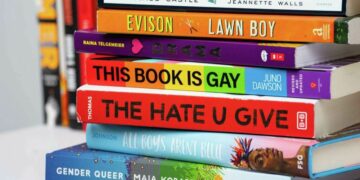













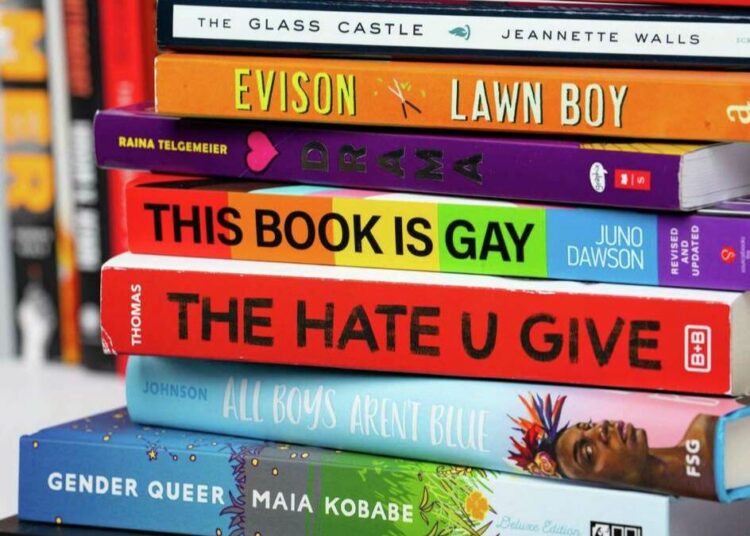



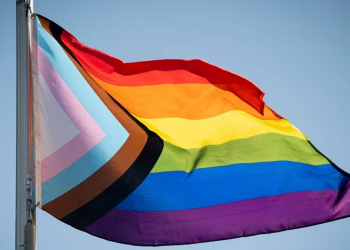

Discussion about this post